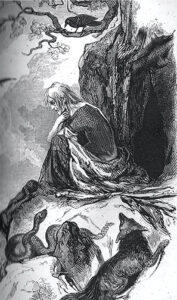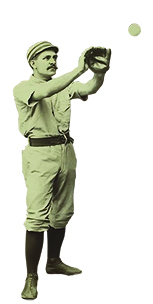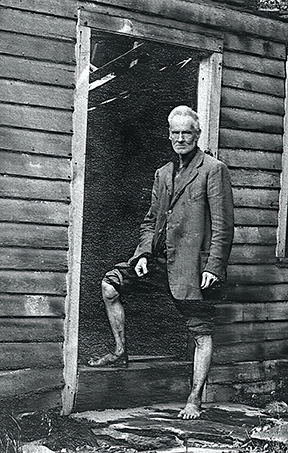What do a pair of hermits, a baseball star, a world-class traitor, a Nobel laureate, an Underground Railroad stationmaster, and a Santa Claus have in common? Ridgefield has roads that are named for them.
The town’s geography has more than 1,200 ancient and modern place names, most describing features of the land, but many recalling noteworthy people of the town’s past. The stories behind some Ridgefield roads are as varied as their colorful namesakes.
Few communities would name a roadway after America’s most notorious traitor, much less issue two medals in his honor. But when Benedict Arnold was in town in 1777, he was a heroic general in the Revolution, fighting the British at the Battle of Ridgefield. Arnold had his horse shot out from under him on Main Street, not far from the entrance to Arnold’s Way, just north of Gilbert Street. Ironically, a half-mile south, King Lane recalls Lt. Joshua King who led Arnold’s spy-mate, Major John Andre, to the gallows in 1780.
A less famous, but equally heroic, Ridgefielder named Edward “Uncle Ned” Armstrong was born just after the Revolution. He and his wife, “Aunt Betsey,” established a station on the Underground Railroad in the 1840s. To hide runaways, these two African Americans used caves on what is now known as Ned’s Mountain, accessed by Ned’s Mountain Road and Ned’s Lane. Four young men who grew up in the Armstrong compound, including two of their grandchildren, joined the Union Army.
 Just to the west of Ned’s Mountain is Sarah Bishop Road, named for a cave-dwelling recluse who made her home in a grotto in a West Mountain outcropping four miles to the south from the late 1700s until 1810. The mysterious hermitess would periodically wander ghostlike down the mountain and into town to attend church services and acquire meager supplies. One winter she froze to death returning to her cave. Why she chose such a harsh life is unknown, but rumors abounded; one alleged she lost her senses after being jilted by a lover and fled to the remote woods along the state line to forget her past.
Just to the west of Ned’s Mountain is Sarah Bishop Road, named for a cave-dwelling recluse who made her home in a grotto in a West Mountain outcropping four miles to the south from the late 1700s until 1810. The mysterious hermitess would periodically wander ghostlike down the mountain and into town to attend church services and acquire meager supplies. One winter she froze to death returning to her cave. Why she chose such a harsh life is unknown, but rumors abounded; one alleged she lost her senses after being jilted by a lover and fled to the remote woods along the state line to forget her past.
A mile up Ridgebury Road from Ned’s Mountain is Powdermaker Drive, which surprisingly has nothing to do with guns. Sisters Florence and Hortense Powdermaker owned a 100-acre farm there but were hardly farmers. A noted psychiatrist, Florence wrote popular guides to raising children, focusing on making kids feel secure in society. But she also addressed other problems. Just after World War II, she advised the supreme allied commander in Japan on treating servicemen shocked by combat. Hortense was an anthropologist, professor, and author. Her most popular book was Hollywood, the Dream Factory, which examined the film industry. However, her most significant book came after spending three years living in a small Mississippi town and observing its people. After Freedom (1939) was a pioneering work on race relations, praised for portraying cultural and class diversity within the African American community, as well as cultural patterns and psychological attitudes in society.
A ride from Ridgebury to town via North Salem Road brings you past Farrar Lane. In 1924, Sidney Farrar bought a 30-acre farm there and convinced his daughter, the Metropolitan Opera star Geraldine Farrar, to move to town as well. Back in 1883, Sid Farrar joined the Philadelphia Phillies for the team’s very first season. An expert fielder, he starred at first base for seven years before moving to the Philadelphia Athletics for his final season in 1890. Farrar’s lifetime batting average over 943 games was .253, with 905 hits and 18 home runs. Before retiring to Ridgefield, he’d been a Massachusetts merchant.
A mile up North Salem Road near the New York line is O’Neill Court, across the highway from Brook Farm, the 1920’s retreat of playwright Eugene O’Neill. Known for such classics as Long Day’s Journey into the Night, Desire Under the Elms, and Ah, Wilderness, O’Neill earned a Nobel Prize in literature and four Pulitzers for his plays. A city boy, he was spooked by this quiet country home, fearing at times he was being watched from behind as he wrote or that someone was walking around and around his house. Yet, when he was selling the place in 1927, he told his wife, “Going to Ridgefield made me sad. It’s so beautiful right now, and I can’t help feeling more keenly than ever that that’s where our family ought to be.”
Back in the center of town, one might traverse Copps Hill Road past Copps Hill Plaza shopping center. Though he never owned land here, John Copp was instrumental in settling Ridgefield in the early 1700s. He helped Norwalk pioneers explore this new territory and surveyed the town’s first boundaries. Copp then served as town clerk, laid out Main Street and its homelots, acted as a physician to the settlers, and was the town’s first schoolteacher. He nonetheless remained a resident and prominent citizen of neighboring Norwalk, where, just off the shoreline, Copp’s Island keeps his name alive.
Driving east through Farmingville, one will find Cain’s Hill Road, named for Revolutionary War sergeant Hugh Cain who established a cloth processing mill on the Norwalk River. Nearby, we might turn south on Route 7 and pass Ashbee Lane. This little road recalls Charley Ashbee, a Manhattan insurance executive who came here in 1929 and each holiday season for decades, became Ridgefield’s Santa Claus. He was so beloved that when he was 88 and in failing health at a local nursing home, scores of children and adults, some of whom had sat on his lap as kids, came to visit him.
 The return to town via Florida Hill Road passes Hermit Lane, named for George Washington Gilbert, Ridgefield’s “other” hermit. But unlike Sarah Bishop, Gilbert loved company. People from far and wide would visit him at his family homestead, an ancient saltbox, literally crumbling around him. The often-barefoot eccentric would tell stories, offer math puzzles and pose for pictures — a half-dozen different postcards depicting him and his dilapidated house were published. A neighbor eventually took pity and built him a cottage, but one winter he ran out of wood and, like Sarah Bishop, froze to death.
The return to town via Florida Hill Road passes Hermit Lane, named for George Washington Gilbert, Ridgefield’s “other” hermit. But unlike Sarah Bishop, Gilbert loved company. People from far and wide would visit him at his family homestead, an ancient saltbox, literally crumbling around him. The often-barefoot eccentric would tell stories, offer math puzzles and pose for pictures — a half-dozen different postcards depicting him and his dilapidated house were published. A neighbor eventually took pity and built him a cottage, but one winter he ran out of wood and, like Sarah Bishop, froze to death.
Driving through Ridgefield is like turning the pages of the town’s history. These are just a few of the street signs that have a story to tell: maybe your street has one too!
The book, Ridgefield Names, is available at Books on the Common, Keeler Tavern Museum, and the historical society. •